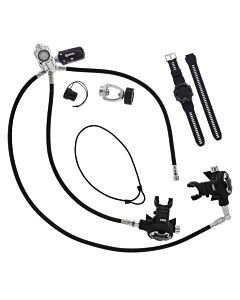Mares XR - Sirius
Mares' flagship extended range dive computer, the Sirius is wrist-watch style with technology both for the sport and technical diver.
ADVISORY: Dive electronics are shipped as "Signature Required", but you may use the appropriate USPS Informed Delivery®, UPS My Choice®, or DHL On Demand™ website to authorize delivery without signature.
-
 Mares Sirius$999.95
Mares Sirius$999.95
ZHL, VPM, RGBM, DSAT, DCIEM, DCAP ... Does It Really Matter?
At the risk of annoying those who do have a preference for a specific decompression algorithm, the simple answer for most recreational divers is NO the algorithm is not critical. There is no expert consensus that any one of the current crop of decompression algorithms is better than another. All of these algorithms used in dive computers and desktop table generation software, when set to their default conservancy values and configured to match the actual breathing gas compositions, will get you out of the water with a reasonable margin of safety for recreational diving. What we can say for sure is they are all imperfect representations of actual decompression in humans.
There is extensive information on the internet regarding most of the decompression algorithms in dive computers, so we won't review their details in this brief tek-tip. Unfortunately, some dive computer decompression algorithms contain proprietary modifications (or are entirely proprietary) and are not subject to public inspection or review. Here is a short description of the deco algorithms offered in some of the current dive computers on the market...
- Bühlmann ZHL algorithms are implementations of the Haldaian mathematical decompression model of gas saturation in various tissues (today more properly termed 'compartments') and are seen in numerous variations for both sport and technical dive computers. For planned stop-required diving, versions of ZHL-16 that include user configurable Gradient Factors are very popular because the GF values can be "tuned" to provide different types of profiles for specific types of diving. Apeks, Divesoft, Garmin, Mares (Sirius model only), Ratio, and Shearwater dive computers use ZHL-16 algorithms by default. Aqualung, Scubapro (aka Uwatec) and some Mares dive computers use other versions of the Bühlmann ZHL algorithms along with proprietary modifications.
- VPM-B (a version that includes adjustments for Boyles Law effects) is a decompression algorithm that attempts to predict the behavior of gas bubbles within the human body during decompression. VPM-B produces dive profiles that typically have deeper initial stops, along with reduced time at shallow depths resulting in a 'smoother' profile. VPM-B is popular among the technical diving community for use with dives that have required stops. However, recent research calls into question the benefits of 'deep stops' especially for lengthy VPM-B profiles. Some Ratio and Shearwater dive computers offer VPM-B algorithms as an alternative to Bühlmann.
- RGBM has its roots in VPM in that it is also a bubble model, but makes different assumptions than VPM about bubble behavior. Most experts consider the RGBM model to be very conservative and some sport divers find it to be too conservative, especially on repetitive dives. Atomic, Cressi, Suunto, and some Mares dive computers use versions of the proprietary RGBM algorithm.
- DSAT is a proprietary modification of the US Navy tables based on research for the PADI Recreational Dive Planner. DSAT is considered relatively liberal for no-stop required diving, especially repetitive and multi-level dives within the sport depth limits. Some dive computers manufactured by Pelagic (OEM owned by Aqualung) for other brand names, such as Oceanic and Sherwood, offer DSAT as an alternative to their proprietary Pelagic Z+ (based on ZHL-16.)
- DCIEM is a serial decompression model that assumes gas transfers simultaneously between the compartments, unlike parallel models where gas diffusion is assumed to occur independently in each compartment. In serial decompression models only one compartment is assumed to be exposed to ambient pressure. DCIEM is proven to be well suited to strenuous cold-water activities typical of commercial divers. Shearwater offers a DCIEM option for some of their dive computers.
- DCAP was developed for use in military and commercial mixed-gas diving applications. DCAP calculations are based on inspired gas values, but most other models use dissolved gas values. The inspired gas model is well suited to closed circuit rebreathers and a version of the DCAP algorithm is the default decompression model used in the modern Poseidon rebreather and their M28 dive computer.
If you don't understand the differences between the decompression algorithms and why you would choose one or another, Dive Gear Express recommends a dive computer configured with a non-proprietary implementation of the Bühlmann ZHL-16 decompression algorithm along with the computer default setting for conservancy.
The practices of decompression are not exact, in many ways as much about skill as science. Much of what we do in decompression diving is based on empirical observation and experience, rather than having a basis in theoretical science. Dr. R W "Bill" Hamilton, the late co-developer of DCAP and whose research in decompression is widely acknowledged as having a key role in opening up recreational extreme exposure diving in the early 90's, was fond of the saying "what works, works." The most important safety factor is not the decompression algorithm you select, rather your skill as a diver and that you closely follow the recommendations of that algorithm and safe diving practices in general. Also, best practice when technical diving as a team is that all divers should use the same algorithm in order to remain together as a team during ascent phase of the dive plan.





